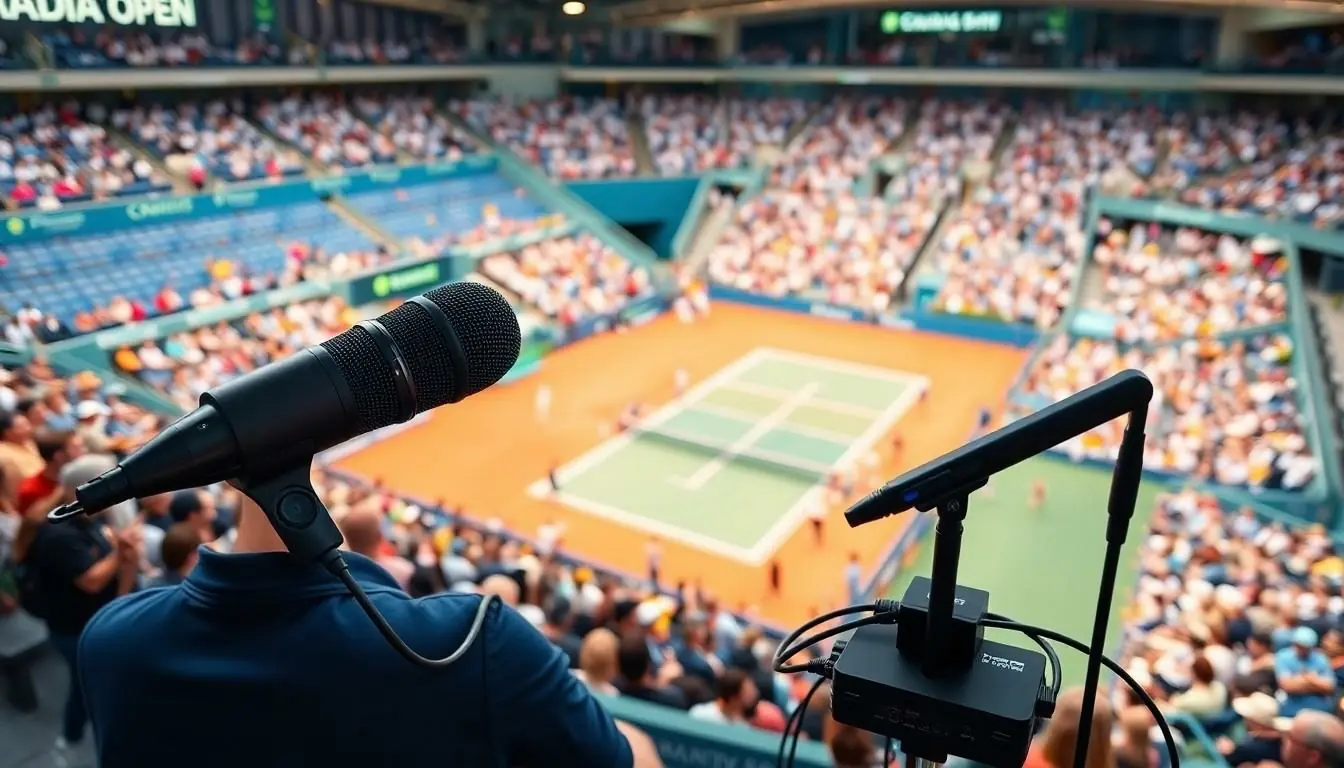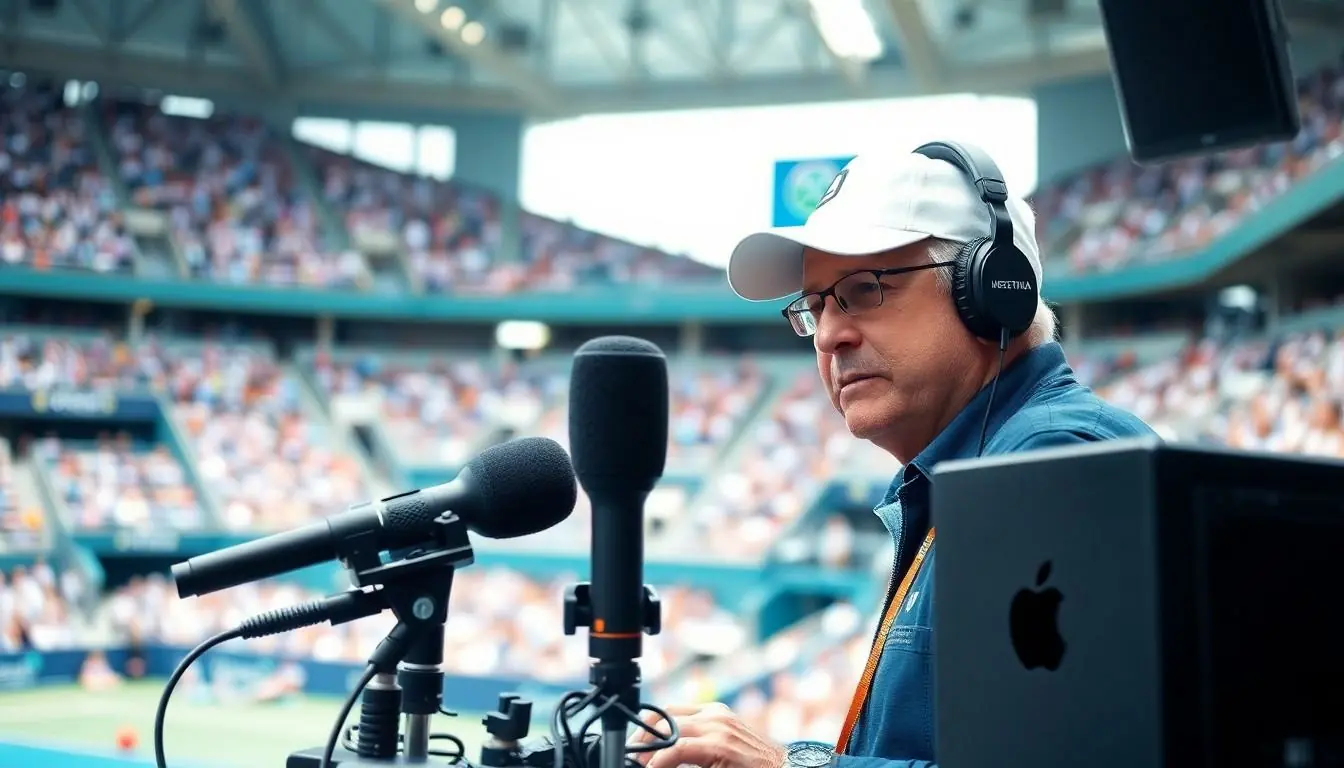As the Australian Open serves up thrilling matches, it’s not just the players who steal the show. Behind the scenes, a team of audio tech wizards ensures every grunt, racket crack, and crowd cheer resonates perfectly. These unsung heroes use cutting-edge technology to transform the tennis experience into a symphony of sound, making fans feel like they’re courtside—even if they’re thousands of miles away.
Table of Contents
ToggleOverview of Audio Technology in Sports
Audio technology plays a vital role in sports, enhancing fan engagement through immersive sound experiences. Advanced sound systems capture every detail of live events, ensuring that audiences hear everything from ball strikes to player movements. At major tournaments like the Australian Open, audio technicians leverage high-quality microphones and speakers to deliver crystal-clear audio.
Sound design also contributes to shaping the atmosphere during matches. Spectators enjoy synchronized audio to the visual experience, elevating the overall enjoyment. For instance, crowd cheers and player reactions are expertly mixed to create a more dynamic environment.
Wireless technology further enhances audio reliability. Technicians use wireless microphones for commentators and players, minimizing cable clutter and optimizing mobility. This technology allows seamless communication among team members, facilitating quick adjustments during events.
Real-time audio processing ensures that sound quality remains consistent. Teams monitor levels continuously to prevent feedback and distortion. With precise adjustments, they maintain clarity while accommodating various conditions, including outdoor elements.
Innovations in audio technology allow for creative applications, such as sound effects during match points. These effects amplify key moments, creating excitement that resonates with viewers. Fans experience these enhancements even in remote locations through streaming services.
The integration of audio technology in sports events transforms the spectator experience. Continuous advancements provide tools that enrich the atmosphere and influence player performance. As more developments emerge, audio plays an increasingly crucial role in creating memorable sports experiences.
The Role of Audio Technology at the Australian Open

Audio technology plays a significant role at the Australian Open, enhancing the overall experience for fans and participants alike.
Enhancements in Fan Experience
Audio systems at the Australian Open elevate fan engagement through immersive soundscapes. Captivating crowd cheers and player sounds enhance the atmosphere, transporting viewers to the heart of the action. High-quality microphones capture detailed audio, ensuring spectators enjoy every baseline hit and player shout. Sound design synchronization with visual elements creates a dynamic experience, promoting excitement and tension during critical match moments. Streaming services also benefit from this technology, providing remote viewers with clear and vivid audio, bridging the gap between in-person and virtual attendance.
Audio Communication for Players and Staff
Audio technology facilitates seamless communication among players and staff during matches. Reliable audio systems ensure that coaches can relay tactical instructions without disrupting the game atmosphere. Wireless headsets promote mobility for staff, allowing them to coordinate efficiently from various locations within the venue. Real-time audio monitoring prevents feedback, contributing to clear communication channels. Proper communication through audio aids in quick decision-making, enhancing players’ performance on the court while ensuring that support staff remains synchronized throughout the event.
Key People Behind Audio Innovations
Audio technology thrives at the Australian Open thanks to talented professionals who enhance the event’s auditory experience. These key individuals play critical roles, enabling immersive soundscapes for all attendees.
Profiles of Leading Audio Technologists
Leading audio technologists possess expertise in sound capture and processing. They utilize advanced equipment to ensure audio clarity and fidelity during matches. Experience in high-pressure environments allows them to adapt quickly to dynamic situations on the court. Many have backgrounds in broadcasting or live event production, bringing valuable skills to the world of sports. Technical knowledge in wireless systems and real-time audio monitoring enhances their capabilities, ensuring consistent sound quality throughout the tournament.
Contributions of Audio Engineers at the Event
Audio engineers contribute significantly to the overall atmosphere during the Australian Open. Their tasks involve strategically placing microphones and speakers throughout the venue. They monitor audio levels continuously, preventing feedback and distortion that could disrupt the audience’s enjoyment. Creative sound design adds excitement during pivotal match points, enhancing fans’ experiences both in the stadium and online. Coordination with other technical teams ensures seamless integration of audio and visual elements, helping to create a captivating environment. Effective communication tools facilitate interaction among players, coaches, and staff, promoting the smooth execution of matches.
Impact of Audio Technology on the Tennis Experience
Audio technology significantly enhances the atmosphere at the Australian Open. Immersive sound experiences engage fans and keep them connected to the action. Capturing every sound detail, from player movements to the crowd’s reactions, creates a vibrant ambiance for spectators.
High-quality microphones and speakers ensure that every strike of the ball resonates throughout the venue. Sound design integrates smoothly with visual elements, elevating the overall enjoyment of matches. Adapting sound to highlight critical moments boosts excitement, especially during match points.
Wireless technology eliminates cable clutter, allowing for greater mobility among commentators and staff. Consistent audio quality is maintained through real-time processing, with teams actively monitoring levels to eliminate feedback and distortion. Creative sound applications, like adding effects to pivotal points, enhance viewer engagement for remote audiences.
Enhancing the participant experience also plays a vital role in audio dynamics. Immersive soundscapes transport fans to the core of the matches, enriching their connection to the event. Coaches communicate tactical strategies seamlessly, thanks to wireless headsets that allow for discreet coordination.
Audio technicians, including experienced engineers, contribute significantly to this technological landscape. They expertly manage audio levels while collaborating with other technical teams. Placing microphones and speakers strategically enhances the event’s atmosphere, ensuring successful integration of sound and visuals.
Ultimately, audio technology reshapes fan experiences at the Australian Open, becoming an indispensable element in crafting memorable sports events.
Future Trends in Audio Technology at Tennis Events
Emerging audio technologies are poised to redefine the sound experience at tennis events. Artificial intelligence will play a significant role, enabling real-time analysis of crowd reactions and player performance. Integration of augmented reality may allow fans to enjoy personalized audio feeds directly through their devices, enhancing engagement.
Advanced microphone arrays will improve sound capture from multiple angles. These systems will provide a more immersive auditory experience, isolating player sounds from crowd noise more effectively. Spectators will also benefit from enhanced directional audio, allowing them to focus on specific on-court actions.
Wireless technology continues to advance, reducing interference and enhancing signal clarity. Improved wireless headsets will facilitate real-time communication among teams, optimizing tactical coordination during matches. Spectators will enjoy clearer audio transmissions, even from distant seats within the stadium.
Sound design innovations will include the use of spatial audio techniques, creating a 3D sound environment that envelops audiences. These techniques will help reproduce the sensation of being courtside, delivering an audio experience that matches visual excitement. Creative audio effects may amplify key match points, drawing attention to critical moments.
Cloud-based audio processing will enable teams to manage sound levels remotely, allowing technicians to adjust audio feeds dynamically. Automated audio mixing systems may enhance consistency, reducing the possibility of feedback or distortion. Additionally, data analytics will offer insights into audience preferences, guiding audio design decisions for future events.
As technologies continue to evolve, audio experiences will transform at major tournaments. Event organizers will prioritize audio technology to deepen the connection between audiences and the excitement of live tennis. With ongoing advancements, the future of audio technology at tennis events promises to elevate fan experiences significantly.
The impact of audio technology at the Australian Open cannot be overstated. It transforms the way fans experience tennis by creating an immersive environment that captures every crucial moment. From the intricate sound design to the innovative use of wireless technology, these advancements ensure that audiences feel connected to the action, whether they’re in the stands or watching from home.
As the field of audio technology continues to advance, the future looks bright for enhancing live sports events. The ongoing commitment to improving sound quality and engagement will undoubtedly elevate the overall experience for fans and players alike. With each tournament, audio professionals are setting new standards that redefine how the excitement of tennis is shared with the world.

